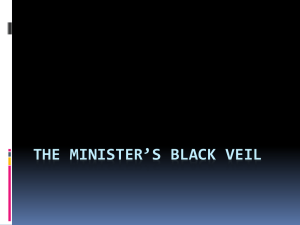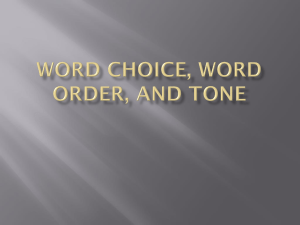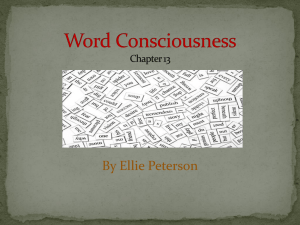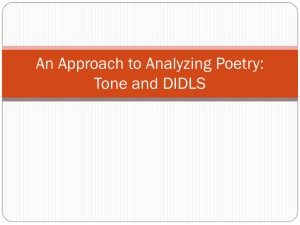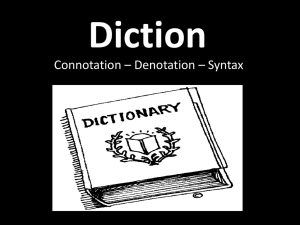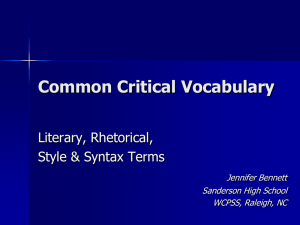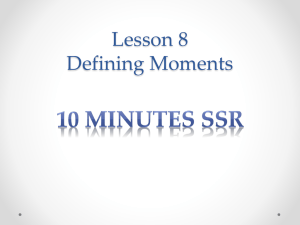Tone/Diction Overview
advertisement
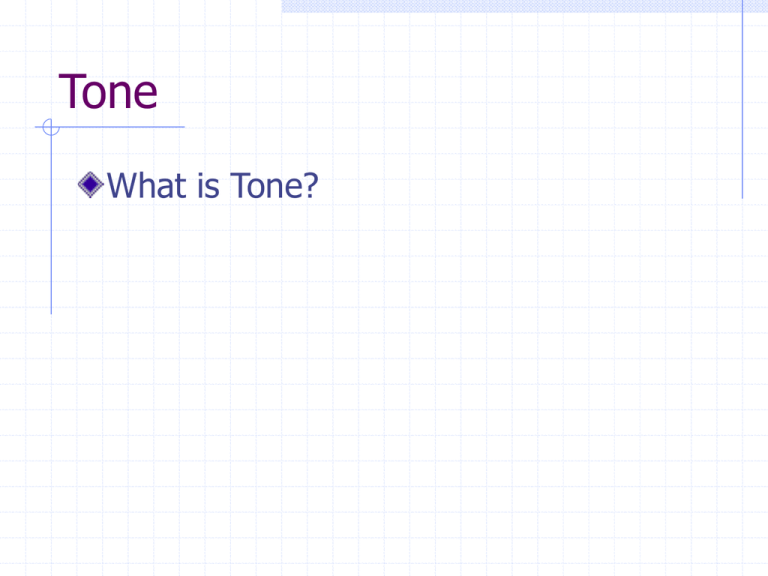
Tone What is Tone? Tone What is Tone? The writer’s or speaker’s attitude toward a subject, character, or audience Conveyed through the author’s choice of words, detail, imagery, and language Tone In order to understand tone, we must understand how our choice of words (or Diction) effects the tone Diction What is diction? Diction What is diction? Diction is word choice intended to convey a certain effect Diction What is diction? Diction is word choice intended to convey a certain effect To communicate ideas and impressions To evoke emotions To convey your views of truth to the reader Diction Levels of Diction High or Formal Diction Neutral Diction Low or Informal Diction Words to Describe the Language Jargon Slang Colloquial Formal Informal Concrete Abstract Connotative Esoteric Plain Detached Pedantic Pretentious Ordinary Learned Simple Bombastic Grotesque Poetic Picturesque Provincial Obscure Exact Vulgar Insipid Precise Artificial Literal Emotional Euphemistic Sensuous Exact Symbolic Figurative Obtuse Moralistic Idiomatic Cultured Scholarly Types of Diction Monosyllabic (one syllable) Polysyllabic (more than one syllable) Types of Diction Concrete – specific words that describe physical qualities or conditions Abstract – language that denotes ideas, emotions, conditions, or concepts that are intangible Types of Diction Slang – a group of recently coined words (informal and goes out of style) Jargon – words and expressions characteristic of a particular trade, profession, or pursuit (Moby Dick) Dialect – nonstandard subgroup of a language with its own vocabulary and grammatical features; it often reveals a person’s economic or social class (The Skin I’m In) Types of Diction Denotation – the exact, literal definition of a word Connotation – the suggestions, associations, and emotional overtones attached to a word (house/home) Types of Diction Figurative Language Simile – compares 2 things using ‘like’ or ‘as’ The warrior fought like a lion Types of Diction Figurative Language Metaphor – compares 2 things without using ‘like’ or ‘as’ Time is money Types of Diction Figurative Language Personification – a kind of metaphor that gives inanimate objects or abstract ideas human characteristics The wind cried in the dark Types of Diction Figurative Language Onomatopoeia – the use of words that mimic the sounds they describe hiss, buzz, bang Types of Diction Figurative Language Alliteration – beginning several consecutive or neighboring words with the same sound The twisting trout twinkled below Types of Diction Figurative Language Idioms – an expression that means something different than its literal meaning He kicked the bucket Levels of Diction Levels of Diction Levels of Diction What Level of Diction? Ordinary? Informal? Formal? Informal? Ordinary? Formal? Levels of Diction Diction List the Clock Exercise Presented with a vague or general word such as “house,” and you generate a list of specific words to replace that word home, domicile, castle, residence, etc. Diction Funny Diction Sad Diction Happy Diction Upset Writing Exercise Respond to the prompt Write a minimum of one page DO NOT use the same word more than once in the entire page Prompt If you could become an expert in any profession, sport, or activity, what would you choose and why? OR Write about jealousy. Tell a story about yourself; write about someone you are jealous of. Give jealousy a voice. OR Explore the subject of illness. Select a moment of personal experience of being sick or being a caregiver.

